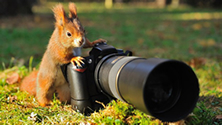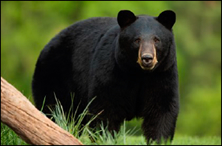Before the Trip & While Recreating: The Seven Principles of Leave No Trace
Please adopt the backcountry ethic of "take only photographs and leave only footprints"
Plan Ahead & Prepare
Prepare for all types of weather. Don't forget clothing that will protect you from cold, heat, or rain. Know your route. Learn about the area before you visit. Read books and talk to people about the area. Obtain maps for reference and to show others where you are planning to visit. If ascending peaks, try to be descending by noon to avoid afternoon storms. Ensure that a friend or family knows where you are headed, what trail(s) you are intending on using, and an estimate of when you will return.
In Case of Any Emergency, Always Call 911
Travel & Camp on Durable Surfaces
Stay on the main trail to protect natural resources. If no trail exists, travel on a durable surface such as rock or snow. Utilize existing campsites whenever possible to help minimize your impact on that area. Always camp 100 feet from roads and trails and 200 feet from water sources. Always camp below tree line to avoid damaging alpine areas; they are incredibly fragile and once damaged, may never grow back.
Don't Sleep in the Same Clothes You Cook in
You don't want to smell like food to the wildlife.
Dispose of Waste Properly
Pack it in, pack it out. Utilize bathrooms or outhouses when available. When they are not, be sure to dig a hole at least 8 inches deep, at least 200 fee from water, and 100 feet from the trail. There are several options for disposing of toilet paper; bury it in the hole, burn it, or put it in a plastic bag and dispose of it in the garbage. When above tree line, human waste and food will not decompose. Throw away your food scraps and utilize a "wag bag" in these areas.
Leave What You Find
Leave plants, rocks, animal and historical items as you find them for others to enjoy. Good campsites are found, not made. Don't dig trenches or structures in your campsite. Hacking or peeling plants can kill them.
Minimize Campfire Impacts
Utilize a camp stove to prepare meals. Use existing fire rings and keep your fires samll and manageable. Collect loose sticks from the ground. Be sure the fire is dead and out before you leave your campsite.
* Contact Your Local Forest Service Office Before Your Trip to Determine if There are Fire Restrictions in Place *
Respect Wildlife
Be quiet and keep your distance. Never approach, feed, or follow animals. Keep control of your pets at all times. In wilderness areas, pets must be leashed at all times. Store your food and trash appropriately. Bear hangs and bear boxes may be required. Check with the Forest Service Offices for special orders regarding food storage.
Be Considerate of Other Visitors
Travel in small groups. Talk quietly. You will see more animals if you are quiet. Remember that other visitors are there to enjoy the outdoors as well.
Allow Horses Plenty of Room on Trails
Move the group off to one side of the trail (downhill side is best) and avoid sudden movements as horses pass. Mountain bikes yield to horses and hikers. Hikers yield to horses and bikers.
What You Need to Hike in Park County
Make a plan and stick with it, climb early to be off the mountain and back to tree line before noon, and never travel alone.
Begin With the Essentials
Sunscreen, Lip Balm, Sunglasses (are recommended to prevent burns and reduce the chance of skin cancer) Food, Water, Map, Compass, GPS, Shelter, First Aid Kit, a flashlight and a headlamp, Batteries, a Whistle, and Friends. Don't forget Food and Water if Fido comes along.
Wildlife Safety Tips for Enjoying the Great Outdoors
Be aware of your surroundings and what animals may be present that could pose a threat in that environment. Never feed wild animals, even squirrels or chipmunks. Keep them wild and don't risk attracting predators. If you are camping, keep the area clean. Wash all cooking utensils after use and store leftover food in airtight containers. REPORT ANY WILDLIFE ATTACKS TO 911.
Wildlife Watching
 You see an animal.
You see an animal.
You get excited!
You want to stop.
You want to get a picture!
Please do...but first remember...Be Courtesous! Pull a safe distance off the road. Depending on the animal, it could be dangerous to get out of your vehicle, so exercise extreme caution.
Bears
 Watch for signs of recent bear traffic...crushed plants, scat, or fresh tracks. Travel in groups, making a lot of noise. Store your food & garbage properly. If encountered and they do not see you, quietly move away and use another trail. Back away in teh direction from which you came. If the bear is aware of you, talk calmly and face the bear. Stand still and stay calm. If it does not approach, back away slowly until you are a safe distance to leave the area. Always carry Bear Spray. Never come between a cub and Mom or approach a bear or run from them. Bears can sprint at 40mph. If attacked or knocked down by a defensive bear, roll on your stomach and "play dead". The bear will leave when it perceives you are not a threat. Most charges by bears are defensive, not predatory.
Watch for signs of recent bear traffic...crushed plants, scat, or fresh tracks. Travel in groups, making a lot of noise. Store your food & garbage properly. If encountered and they do not see you, quietly move away and use another trail. Back away in teh direction from which you came. If the bear is aware of you, talk calmly and face the bear. Stand still and stay calm. If it does not approach, back away slowly until you are a safe distance to leave the area. Always carry Bear Spray. Never come between a cub and Mom or approach a bear or run from them. Bears can sprint at 40mph. If attacked or knocked down by a defensive bear, roll on your stomach and "play dead". The bear will leave when it perceives you are not a threat. Most charges by bears are defensive, not predatory.
Mountain Lions
 Mountain Lions tend to be elusive and typically avoid people. Avoid hiking, biking, or jogging when they are most active...dawn, dusk and at night. Do outdoor activities in groups and supervise children at all times. Do not approach a mountain lion or make it feel trapped.
Mountain Lions tend to be elusive and typically avoid people. Avoid hiking, biking, or jogging when they are most active...dawn, dusk and at night. Do outdoor activities in groups and supervise children at all times. Do not approach a mountain lion or make it feel trapped.
Most mountain lions will try to avoid confrontation and look for an escape. If encountered, never run, and do not crouch down or bend over. A human standing erect does not resemble a lion's natural prey. Do everything you can to appear larger such as, raising your arms, waving a jacket around, speaking in a loud voice, and throwing rocks or other objects. Fight back if attacked.
Moose
 Typically Moose want nothing to do with you, but they are temperamental and unpredictable. Never get between a mother and her calves. A Moose will charge when it?s stressed, hungry, cornered, and weather conditions such as deep snow can make them more irritable than usual. Dogs bother them. During mating and calving season, they are especially aggressive.
Typically Moose want nothing to do with you, but they are temperamental and unpredictable. Never get between a mother and her calves. A Moose will charge when it?s stressed, hungry, cornered, and weather conditions such as deep snow can make them more irritable than usual. Dogs bother them. During mating and calving season, they are especially aggressive.
If encountered, do give them plenty of space...at least 50 feet. Watch for raised hackles along shoulders, ears pinned back, and a lowered head. If you're charged, run for solid cover like a tree, curl into a ball, and stay still. They might kick and stomp until they feel you are no longer a threat, then move on.